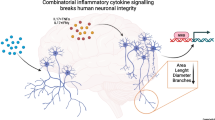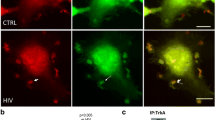Abstract
Lesions of the central nervous system elicit inflammatory responses that counteract the regeneration of neurites. Microglia and infiltrating macrophages that were activated by trauma have been identified as cellular sources of inhibitory factors. We examine cultured macrophage (RAW264.7) and neuronal (PC12) cell lines to ascertain the potential modulators of the inflammatory impact on neurons. By exposing quiescent macrophages to lipopolysaccharide (LPS) and interferon γ (IFN-γ), cells can be transformed into an activated M1 phenotype. Neurite extension was induced in PC12 cells by culturing them in the presence of nerve growth factor. Neurite outgrowth was quantified by analyzing immunofluorescence and phase contrast microscopy images. Activated macrophages significantly reduced neurite extension. Macrophage activation by LPS/IFN-γ induced a 1000-fold increase in tumor necrosis factor alpha (TNF-α) secretion, as quantified by enzyme-linked immunosorbent assays (ELISA). Recombinant TNF-α inhibited neurite formation at concentrations as low as 0.016 ng/ml. In contrast, the masking of TNF-α with specific functional antibodies abrogated neurite growth inhibition by activated macrophages. Taken together, these results indicated that TNF-α is a key component of inhibitory macrophage action. The transfection of PC12 neurons with microRNA-124 (miR-124) counteracted the inhibition of neurites mediated by both recombinant TNF-α and macrophages. miR-124 did not stimulate neurite formation per se, nor was cell viability affected. These data suggest that miR-124 might be a valuable tool for desensitizing neurons to a repulsive inflammatory environment.







Similar content being viewed by others
References
Bak M, Silahtaroglu A, Moller M, Christensen M, Rath MF, Skryabin B, Tommerup N, Kauppinen S (2008) MicroRNA expression in the adult mouse central nervous system. RNA 14:432–444
Baudet ML, Zivraj KH, Abreu-Goodger C, Muldal A, Armisen J, Blenkiron C, Goldstein LD, Miska EA, Holt CE (2011) miR-124 acts through CoREST to control onset of Sema3A sensitivity in navigating retinal growth cones. Nat Neurosci 15:29–38
Biswas SK, Sodhi A (2002) In vitro activation of murine peritoneal macrophages by monocyte chemoattractant protein-1: upregulation of CD11b, production of proinflammatory cytokines, and the signal transduction pathway. J Interferon Cytokine Res 22:527–538
Blight AR (1994) Effects of silica on the outcome from experimental spinal cord injury: implication of macrophages in secondary tissue damage. Neuroscience 60:263–273
Boschmann M, Engeli S, Adams F, Gorzelniak K, Franke G, Klaua S, Kreuzberg U, Luedtke S, Kettritz R, Sharma AM, Luft FC, Jordan J (2005) Adipose tissue metabolism and CD11b expression on monocytes in obese hypertensives. Hypertension 46:130–136
Bristol JA, Morrison TE, Kenney SC (2009) CCAAT/enhancer binding proteins α and β regulate the tumor necrosis factor receptor 1 gene promoter. Mol Immunol 46:2706–2713
Donnelly DJ, Longbrake EE, Shawler TM, Kigerl KA, Lai W, Tovar CA, Ransohoff RM, Popovich PG (2011) Deficient CX3CR1 signaling promotes recovery after mouse spinal cord injury by limiting the recruitment and activation of Ly6Clo/iNOS+ macrophages. J Neurosci 31:9910–9922
Edbauer D, Neilson JR, Foster KA, Wang CF, Seeburg DP, Batterton MN, Tada T, Dolan BM, Sharp PA, Sheng M (2010) Regulation of synaptic structure and function by FMRP-associated microRNAs miR-125b and miR-132. Neuron 65:373–384
Franke K, Otto W, Johannes S, Baumgart J, Nitsch R, Schumacher S (2012) miR-124-regulated RhoG reduces neuronal process complexity via ELMO/Dock180/Rac1 and Cdc42 signalling. EMBO J 31:2908–2921
Gao Z, Zhu Q, Zhang Y, Zhao Y, Cai L, Shields CB, Cai J (2013) Reciprocal modulation between microglia and astrocyte in reactive gliosis following the CNS injury. Mol Neurobiol 48:690–701
Gendelman HE (2002) Neural immunity: friend or foe? J Neurovirol 8:474–479
George A, Buehl A, Sommer C (2004) Wallerian degeneration after crush injury of rat sciatic nerve increases endo- and epineurial tumor necrosis factor-alpha protein. Neurosci Lett 372:215–219
Giulian D, Robertson C (1990) Inhibition of mononuclear phagocytes reduces ischemic injury in the spinal cord. Ann Neurol 27:33–42
Golz G, Uhlmann L, Ludecke D, Markgraf N, Nitsch R, Hendrix S (2006) The cytokine/neurotrophin axis in peripheral axon outgrowth. Eur J Neurosci 24:2721–2730
Gordon S (2003) Alternative activation of macrophages. Nat Rev Immunol 3:23–35
Gu X, Meng S, Liu S, Jia C, Fang Y, Li S, Fu C, Song Q, Lin L, Wang X (2014) miR-124 represses ROCK1 expression to promote neurite elongation through activation of the PI3K/Akt signal pathway. J Mol Neurosci 52:156–165
Kato K, Liu H, Kikuchi S, Myers RR, Shubayev VI (2010) Immediate anti-tumor necrosis factor-alpha (etanercept) therapy enhances axonal regeneration after sciatic nerve crush. J Neurosci Res 88:360–368
Katoh H, Negishi M (2003) RhoG activates Rac1 by direct interaction with the Dock180-binding protein Elmo. Nature 424:461–464
Kaushal V, Schlichter LC (2008) Mechanisms of microglia-mediated neurotoxicity in a new model of the stroke penumbra. J Neurosci 28:2221–2230
Kiefer R, Kieseier BC, Stoll G, Hartung HP (2001) The role of macrophages in immune-mediated damage to the peripheral nervous system. Prog Neurobiol 64:109–127
Kigerl KA, Gensel JC, Ankeny DP, Alexander JK, Donnelly DJ, Popovich PG (2009) Identification of two distinct macrophage subsets with divergent effects causing either neurotoxicity or regeneration in the injured mouse spinal cord. J Neurosci 29:13435–13444
Kosik KS (2006) The neuronal microRNA system. Nat Rev Neurosci 7:911–920
Kozma R, Sarner S, Ahmed S, Lim L (1997) Rho family GTPases and neuronal growth cone remodelling: relationship between increased complexity induced by Cdc42Hs, Rac1, and acetylcholine and collapse induced by RhoA and lysophosphatidic acid. Mol Cell Biol 17:1201–1211
Krichevsky AM (2007) MicroRNA profiling: from dark matter to white matter, or identifying new players in neurobiology. ScientificWorldJournal 7:155–166
Li Q, Bian S, Hong J, Kawase-Koga Y, Zhu E, Zheng Y, Yang L, Sun T (2011) Timing specific requirement of microRNA function is essential for embryonic and postnatal hippocampal development. PLoS ONE 6:e26000
Makeyev EV, Zhang J, Carrasco MA, Maniatis T (2007) The MicroRNA miR-124 promotes neuronal differentiation by triggering brain-specific alternative pre-mRNA splicing. Mol Cell 27:435–448
Mantovani A, Sica A, Sozzani S, Allavena P, Vecchi A, Locati M (2004) The chemokine system in diverse forms of macrophage activation and polarization. Trends Immunol 25:677–686
May V, Schiller MR, Eipper BA, Mains RE (2002) Kalirin Dbl-homology guanine nucleotide exchange factor 1 domain initiates new axon outgrowths via RhoG-mediated mechanisms. J Neurosci 22:6980–6990
Miron VE, Franklin RJ (2014) Macrophages and CNS remyelination. J Neurochem (in press)
Nagata K, Hama I, Kiryu-Seo S, Kiyama H (2014) microRNA-124 is down regulated in nerve-injured motor neurons and it potentially targets mRNAs for KLF6 and STAT3. Neuroscience 256:426–432
Neumann H, Schweigreiter R, Yamashita T, Rosenkranz K, Wekerle H, Barde YA (2002) Tumor necrosis factor inhibits neurite outgrowth and branching of hippocampal neurons by a rho-dependent mechanism. J Neurosci 22:854–862
Pappas TC, Decorti F, Macdonald NJ, Neet KE, Taglialatela G (2003) Tumour necrosis factor‐alpha‐vs. growth factor deprivation‐promoted cell death: different receptor requirements for mediating nerve growth factor‐promoted rescue. Aging Cell 2:83–92
Ponomarev ED, Veremeyko T, Barteneva N, Krichevsky AM, Weiner HL (2011) MicroRNA-124 promotes microglia quiescence and suppresses EAE by deactivating macrophages via the C/EBP-alpha-PU.1 pathway. Nat Med 17:64–70
Popovich PG, Guan Z, Wei P, Huitinga I, van Rooijen N, Stokes BT (1999) Depletion of hematogenous macrophages promotes partial hindlimb recovery and neuroanatomical repair after experimental spinal cord injury. Exp Neurol 158:351–365
Sanuki R, Onishi A, Koike C, Muramatsu R, Watanabe S, Muranishi Y, Irie S, Uneo S, Koyasu T, Matsui R, Cherasse Y, Urade Y, Watanabe D, Kondo M, Yamashita T, Furukawa T (2011) miR-124a is required for hippocampal axogenesis and retinal cone survival through Lhx2 suppression. Nat Neurosci 14:1125–1134
Saville LR, Pospisil CH, Mawhinney LA, Bao F, Simedrea FC, Peters AA, O’Connell PJ, Weaver LC, Dekaban GA (2004) A monoclonal antibody to CD11d reduces the inflammatory infiltrate into the injured spinal cord: a potential neuroprotective treatment. J Neuroimmunol 156:42–57
Schneider CA, Rasband WS, Eliceiri KW (2012) NIH Image to ImageJ: 25 years of image analysis. Nat Methods 9:671–675
Schumacher S, Franke K (2013) miR-124-regulated RhoG. Small GTPases 4
Smirnova L, Grafe A, Seiler A, Schumacher S, Nitsch R, Wulczyn FG (2005) Regulation of miRNA expression during neural cell specification. Eur J Neurosci 21:1469–1477
Sun Y, Li Q, Gui H, Xu D-P, Yang Y-L, Su D-F, Liu X (2013) MicroRNA-124 mediates the cholinergic anti-inflammatory action through inhibiting the production of pro-inflammatory cytokines. Cell Res
Wu D, Murashov AK (2013) Molecular mechanisms of peripheral nerve regeneration: emerging roles of microRNAs. Front Physiol 4:55
Wu D, Raafat M, Pak E, Hammond S, Murashov AK (2011) MicroRNA machinery responds to peripheral nerve lesion in an injury-regulated pattern. Neuroscience 190:386–397
Yu JY, Chung KH, Deo M, Thompson RC, Turner DL (2008) MicroRNA miR-124 regulates neurite outgrowth during neuronal differentiation. Exp Cell Res 314:2618–2633
Acknowledgments
We are grateful to M. Baur, S. Liebler, L. Schuster, A. Stotz, T. Aberle, (NMI Reutlingen, Germany), P. Kingham and M. Wiberg (IMB, Umea, Sweden) and J. Kjems (iNano, Aarhus, Denmark) for scientific and technical assistance. Partially funded by EU/BMBF Nano4Neuro 13N11036.
Author information
Authors and Affiliations
Corresponding author
Rights and permissions
About this article
Cite this article
Hartmann, H., Hoehne, K., Rist, E. et al. miR-124 disinhibits neurite outgrowth in an inflammatory environment. Cell Tissue Res 362, 9–20 (2015). https://doi.org/10.1007/s00441-015-2183-y
Received:
Accepted:
Published:
Issue Date:
DOI: https://doi.org/10.1007/s00441-015-2183-y




